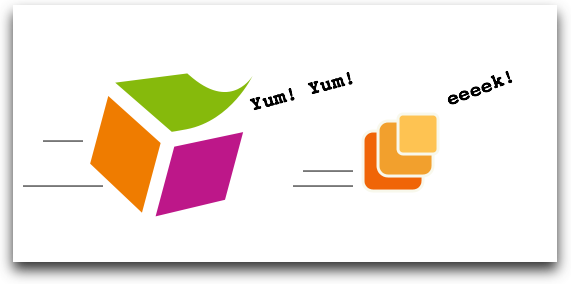People with a good memory (who aren’t hooked on semantic systems like me) may remember that I started roughly a year ago to blog about my PhD. In Step 1 I described the general idea around Semantic Desktop and PIMO, in Step 2 I described my struggle for a research question and the actual scientific goal. Now, that was a year ago and something should have happened in the meantime…
Doing a PhD is a permanent struggle against yourself, god, life as such. If not true, this is at least a view that excuses a student to feel overwhelmed by the task, sit back, open (a can of beer|a bottle of wine) and yearn for life before and after the PhD. In the last year, I did struggling, being overwhelmed, and working on the PhD. I did entagle myself being involved in a lot of other things (such as aperture, nepomuk, burning man decompression, sweo, sesame, my 30th birthday) , which somehow ended up being a lot of things and some of them suffering from diminuished attention. Overwhelmed, we come back to the better reaction than the alcoholic beverage: finishing the PhD by writing it, then improve quality in the other tasks.
The core of the problem is that writing a PhD involves the task of writing. In general, a student can write one page of quality work per work-day. Given the fact that I was involved in a gazillion of things, this drops to one page a week. Oh, a 150 page PhD will then be written in three years. But as I started last year and want to get finished SOON, things had to speed up.
If you do the math for your own work, you can easily finish a PhD by cutting down the pagecount to a reasonable length (less than 100 pages would be excellent). But this means that the pages have to be really good. If you are really good, try writing a PhD in 82 pages like the web-shaking Human Computation by Luis von Ahn. He was able to say the following in his abstract (in my eyes a ticket to finish the PhD right after the first page and get graduated)
In addition, I introduce CAPTCHAs, automated tests that humans can pass but computer programs cannot. CAPTCHAs take advantage of human processing power in order to differentiate humans from computers, an ability that has important applications in practice.
The results of this thesis are currently in use by hundredszillions of Web sites and companies around the world, and some of the games presented here have been played by over 100,000 people. (strikethrough and correction of numbers by me)
Basically, this translates to: my work is pure innovation, or shorter: I rule.
So, not witty enough, I aimed for doing a larger 150 page thesis with the typical parts
- introduction: state of the art (web, knowledge management, ontologies, semantic desktop), problem
- my idea (PIMO + Semantic Desktop for PIM)
- my implementation and algorithms and ontologies
- evaluation
- conclusion: this work is pure innovation, may I rule?
The main parts of the work have been published before in other papers I did on my own and with others, see my publication list for a glimpse of what I refer to.
I took the argumentation, the citations, and the key results from this work and integrated it into one view.
Before, I had a time of “writing it from scratch” and “planning the layout in sections”, I even made a MindManager mindmap of the whole structure.
I ended up having a 200 page document which I called “PhD draft”, but which was actually a copy/pasted frankenstein of my papers, croaking “Pease kill me, Every moment I live is agony!“.
So instead of finishing early, this approach made it actually a bit longer.
The real tricky part was “finishing something”, I then started by finishing the introduction. I wrote it, improved it, printed it, thought about it, sent it to my mother (who has a phd in International Business plus a degree in english translation) to check the english (Mom, thank you so much and I am really lucky to have you!), check it by my colleague Thomas Roth-Berghofer and then by my Professor Andreas Dengel.
And alas, everyone was ok with it. Away frankenstein, welcome results. I was motivated to continue.
This was in August and knowing that I am on the right track, the rest was easy … sort of.
I plowed through section after section, improving the content, adding missing bits, removing redundancy. Today I have a 250 page version that contains most of the things that must be in, missing are a few parts I wanted to do on literature and software engineering lessons learned.
From time to time I talked with my Buddy Sven Schwarz, who is on a similar quest as me, exchanging our status and talking helped to get organized.
So, the next sections can go into review, looking forward to get it done … soon. A good motivation to speed up is the fact that Gunnar has also reached the equilibrium of “its done, only minor changes now”.
 by
by  by
by